The seemingly ordinary coin of the 1965 Nickel has an interesting legacy of its own, and if you are just starting out as a coin enthusiast, you must be looking for more details about it. Whether you are just fascinated with the 1965 Nickel or you want to buy or sell this coin, the following guide is going to be helpful. So, without wasting any more time, let’s get into the details of the 1965 Nickel.
1965 Nickel Detail
- Type: Jefferson Nickel
- Mint Year: 1965
- Mint Mark: No mint mark
- Mint: Philadelphia
- Price: 5 cents-$15.00+
- Face Value: 0.05 USD
- Produced: 1,753,019,400
- Proof Strikes: 2,360,000
- Edge: Smooth
- Composition: 75% Copper – 25% Nickel
- Diameter: 21.2 mm
- Weight: 5 grams
Also Read: 15 Most Valuable Nickels Worth Money
1965 Nickel value chart
| Mint Mark | Extremely Fine | MS63 | MS65 | MS67 |
| 1965 (no mint mark) | $0.15 | $0.25 | $0.50 | $2.50 |
| 1965 SMS | X | $1.50 | $5.00 | $15.00 |
The chart shows that, even in the best condition, a 1965 nickel is often not very valuable. For coins in MS63, MS65, and MS67 conditions, the value rises slightly. The 1965 SMS nickel is a special case, though, since it is a unique and rare type that was only made in Special Mint Sets (SMS) and can reach much higher prices.
The figures shown in the chart are approximations and can change depending on the market, consumer demand, and other elements. A professional coin grader can also offer a more precise evaluation of a particular coin’s worth.
Also Read: Top 110 Most Valuable Nickels Worth Money
1965 Nickel Value and Varieties Guides
The 1965 nickel was minted in three different varieties, each with unique features and values. The following are the varieties of 1965 nickels, along with their distinct characteristics and values.
1965 (P) Nickel Value
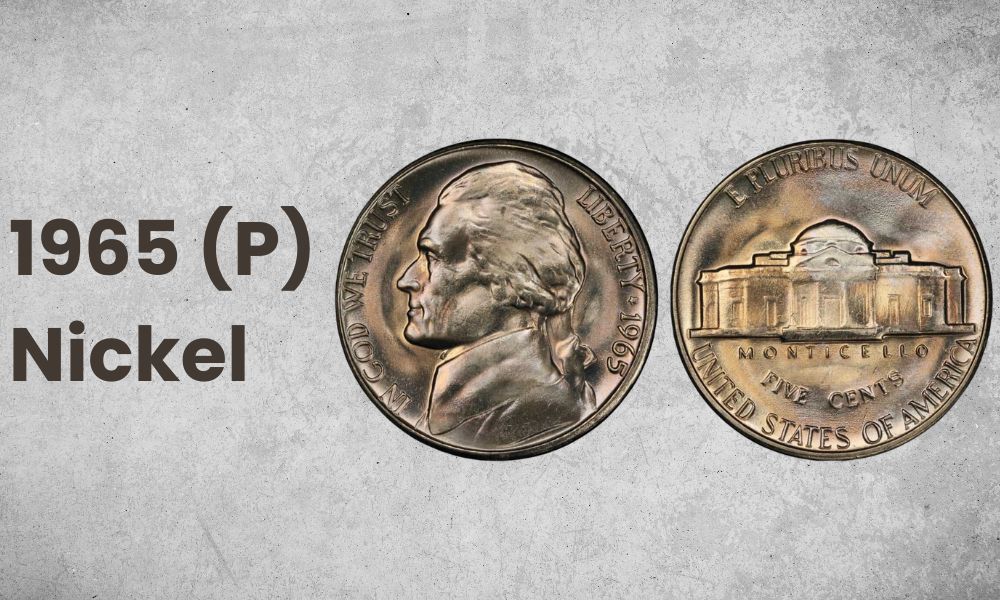
- Type: Jefferson Nickel
- Edge: Plain
- Mint Mark: None
- Place of Minting: Philadelphia
- Year of Minting: 1965
- $ Price: 5 cents to $10 for circulated coins, $15 to $150 for uncirculated coins
- Quantity Produced: 1,576,962,000
- Designer/s: Felix Schlag (obverse), Monticello (Reverse)
The Philadelphia Mint manufactured the 1965 (No Mint Mark) Nickel, which is similar to other nickels from the same year because it lacks a mint stamp. On the obverse side of the coin has a picture of Thomas Jefferson, with the words “Liberty” above, “In God We Trust,” and the year below. Jefferson’s Virginia mansion, Monticello, is shown in reverse. The value of a 1965 (No Mint Mark) Nickel in circulated form ranges from 5 cents to $10, while uncirculated coins might reach prices of $15 to $150.
1965 Special Mint Set (SMS) Nickel
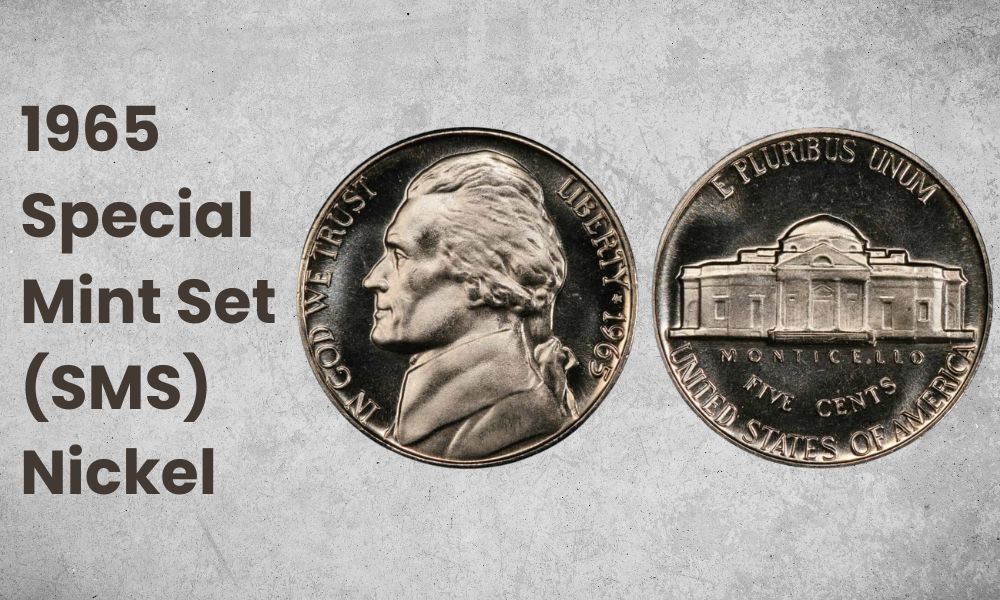
- Type: Jefferson Nickel
- Edge: Plain
- Mint Mark: None
- Place of Minting: Philadelphia
- Year of Minting: 1965
- $ Price: $5 to $100 for circulated coins, $25 to $1,000 for uncirculated coins
- Quantity Produced: Unknown
- Designer/s: Felix Schlag (obverse), Monticello (Reverse)
Among the three 1965 nickel varieties, the 1965 SMS Nickel is the rarest and most expensive. It was produced in limited quantities and was only offered in exclusive mint sets. The coin features a matte appearance as opposed to the bright gloss of the other 1965 nickels. It bears no mint mark and the same design as the 1965 (No Mint Mark) Nickel. In circulated form, the 1965 SMS Nickel is worth $5 to $100, but uncirculated coins can trade for $25 to $1,000 or more, depending on the rarity and quality of the coin.
Also Read: Top 19 Most Valuable Jefferson Nickels Worth Money
History of 1965 Nickel
The United States Mint manufactured the 1965 nickel coin from 1866 up till the present. Felix Schlag, a German immigrant who won the contest to design the new currency in 1938, created this coin. On the obverse is a picture of Thomas Jefferson, while on the reverse is a picture of Monticello, where Jefferson lived. The Nickel weighs 5 grams, has a diameter of 21.21mm, and is made up of 75% copper and 25% nickel.
The 1965 nickel was minted in Philadelphia, Denver, and San Francisco, with a total mintage of 1,753,019,400. On the coin’s reverse, directly above the Monticello structure, is where the mintmark, if any, can be seen.
A 1965 nickel’s value is influenced by a variety of elements, like its condition, mintmark, and any unique characteristics. A 1965 coin that hasn’t been circulated can be worth more than one that has. A 1965 nickel in uncirculated condition is worth between $0.20 and $1.50. If the coin has been used before, it will often be worth less than its face value of 5 cents.
The 1965 nickel’s mintmark could also have an impact on its value. Philadelphia-produced nickels lack mintmarks, but those from Denver and San Francisco do. In particular, if the coin is in great condition, a 1965 nickel with a Denver or San Francisco mintmark might well be worth a little bit more than one with a Philadelphia mintmark.
The value of a 1965 nickel can also be raised by unique characteristics or errors. The 1965 SMS nickel, a Special Mint Set coin, is a good example of this. These coins have a sharper striking and a more radiant finish thanks to the use of highly polished dies and planchets during production. The value of a 1965 SMS nickel in uncirculated condition might reach $30.
The 1965 Jefferson Nickels created some confusion among collectors. To focus on its Special Mint Set sales, the Mint did not operate any of its Branch Mints for a few years. There was still a 1965 nickel in circulation, and it had poor quality despite its age. In contrast, the Mint produced nicer coins for collectors.
However, there is no mintmark on these coins because they were made in San Francisco. Instead of having the appearance of a regular business strike coin, these coins appear to be proof coins. SMS coins were carefully crafted with clear, legible details by the Mint. The inscription “In God We Trust, Liberty” can be found on the obverse of the Jefferson Nickel. On the reverse is the inscription of E Pluribus Unum, Monticello, Five Cents, 5, United States of America. In the obverse, there is a bust of Thomas Jefferson turned to the left, and in reverse, there is a representation of Jefferson’s Monticello house.
In most cases, Jefferson Nickels Five Cents are valued at face value. In spite of this, some coins contain silver, while others are rarer. These coins might have a higher value than they appear. Local coin dealers will attempt to purchase these coins at their face value, but our specialists will make you an offer based on what similar items are selling for at auction.
1965 Nickel Grading
Like other coins, the 1965 nickel is graded according to its quality, shine, wear, and any errors. The Sheldon Scale is used to assess the coin’s grade, which runs from Poor (P-1) to Perfect Uncirculated (MS-70). The grade of a coin may affect its value to collectors; coins with better grades are usually worth more.
To accurately determine the grade of a 1965 cent, collectors should seek the advice of knowledgeable coin graders or specialized reference books. You can get more information on the topic from the following video:
List of 1965 Nickel Error
The 1965 nickel has been in use for a long time; however, there were several production errors that might push up the price of the coin. These mistakes can be small or big, and collectors frequently look for them to add to their collections.
The most noteworthy 1965 nickel mistakes are listed below:
1. 1965 Nickel Clipped Planchet
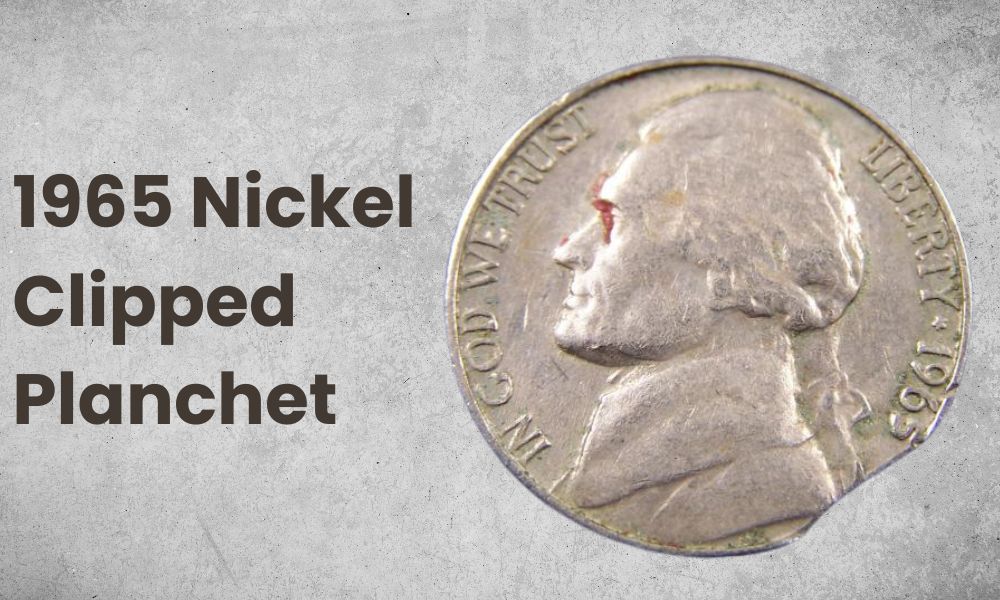
The clipped planchet error is one of several flaws that have been detected on 1965 nickels. This happens when a piece of the metal sheet used to make the coin is removed before striking. This might leave the missing piece’s place on the coin with a straight or curved edge. Depending on the size and placement of the clip, the value of these coins may rise.
2. 1965 Nickel Off-Center
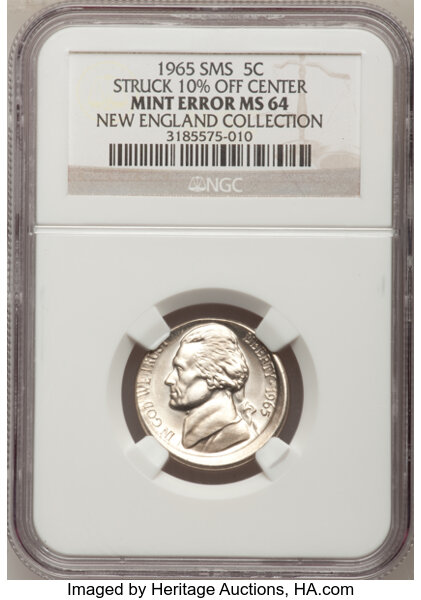
The off-center error is another mistake that may be seen on 1965 nickels. This occurs when the coin’s striking die is not properly aligned, throwing off the design. Depending on how off-center the inaccuracy is and how many design components are lacking, the value of these coins may rise.
3. 1965 Nickel Double Die
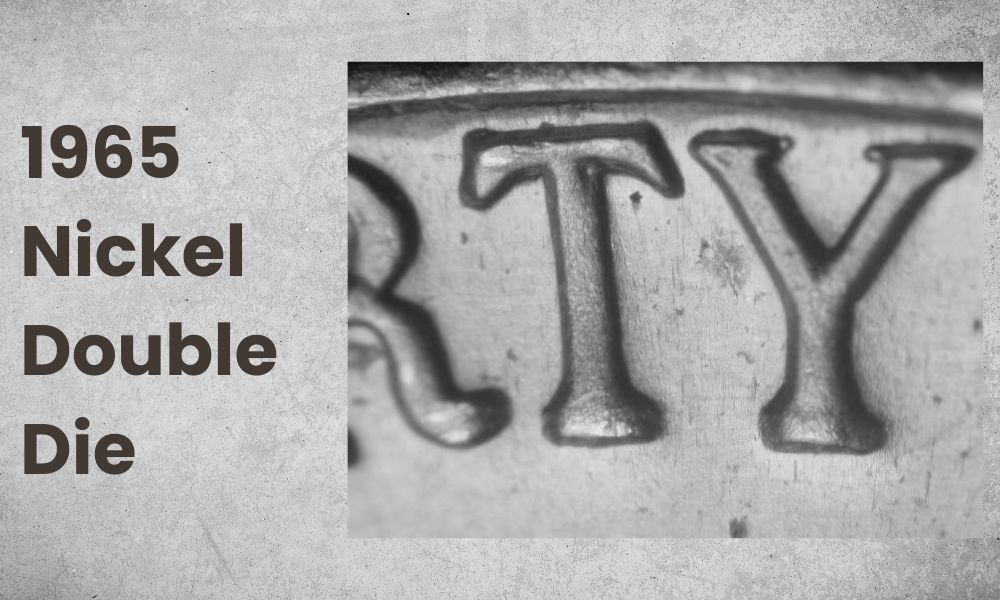
A common error in the area of coin collecting is the double die error. This happens when the coin’s striking die is duplicated, creating a coin with two images that are just off-center from one another. Collectors prize the rarity and high value of the 1965 double-die nickel.
4. 1965 Nickel Die Crack
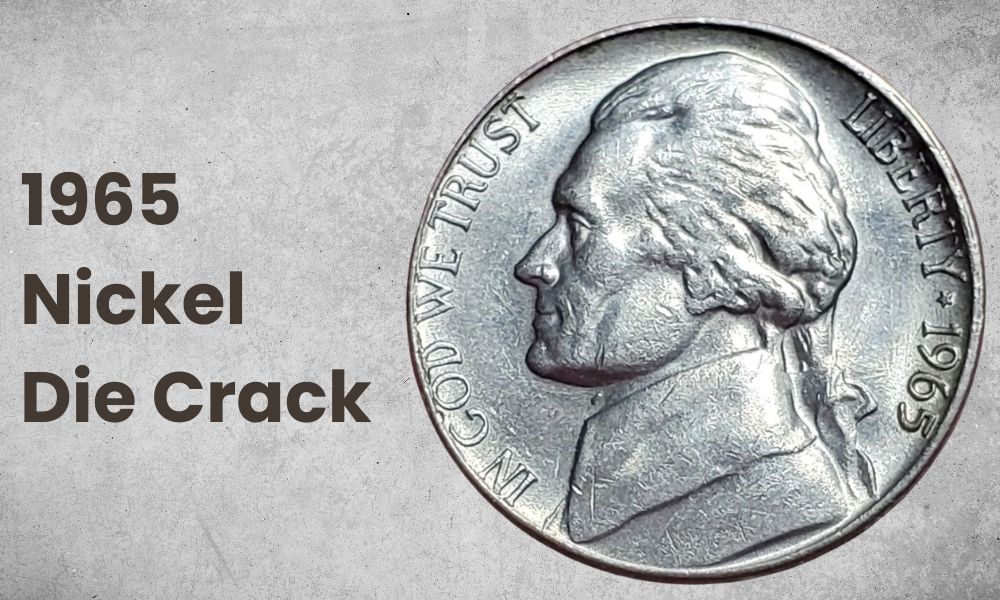
When a fracture develops in the die used to strike the coin, a raised line appears on its surface, which is known as a die crack error. Depending on the visibility and position of the die break, the value of these coins may rise.
5. 1965 Nickel DDO (Doubled Die Obverse)
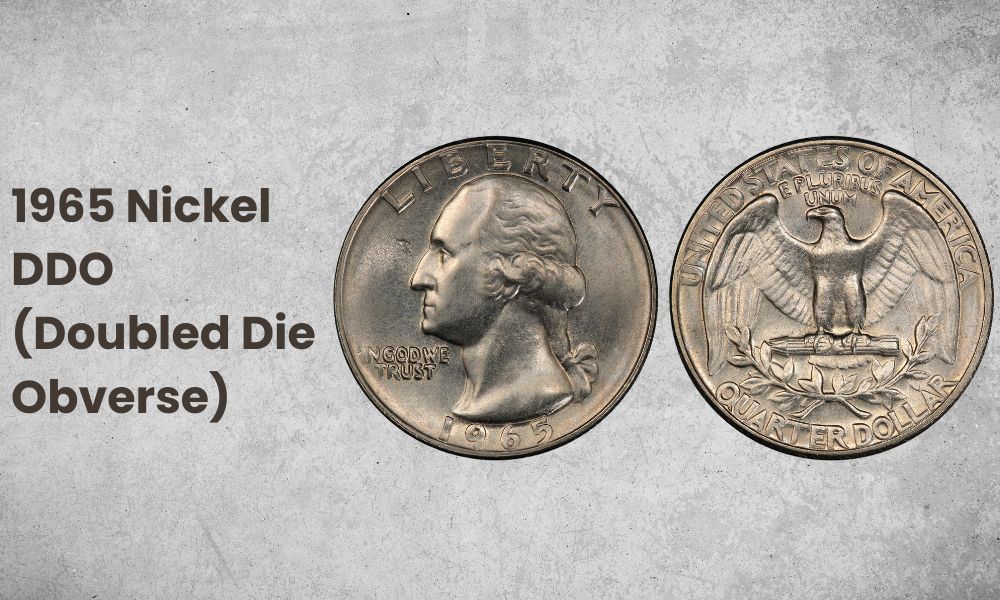
A coin with duplicated design features on the obverse side is the result of the DDO error, which happens when the die used to strike the coin is doubled. Depending on the level of doubling and the number of missing design components, the value of these coins may rise.
6. 1965 Nickel DDR (Doubled Die Reverse)
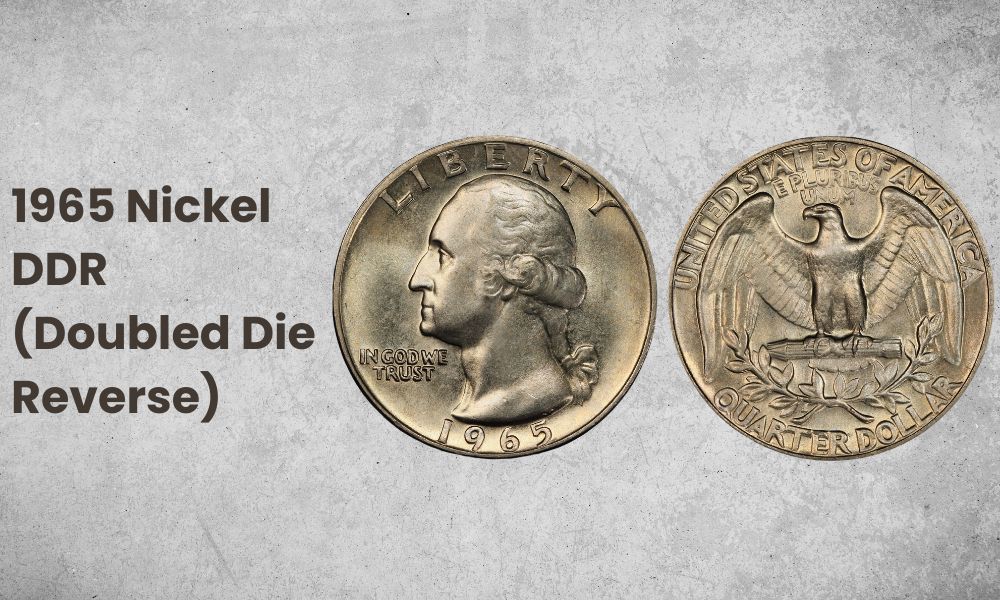
The DDR error, which happens similarly to the DDO error when the coin is struck with a doubled die, produces a coin with duplicated design features on the reverse side. Depending on the level of doubling and the number of missing design components, these coins may see an increase in their value.
7. 1965 Nickel Broadstrike
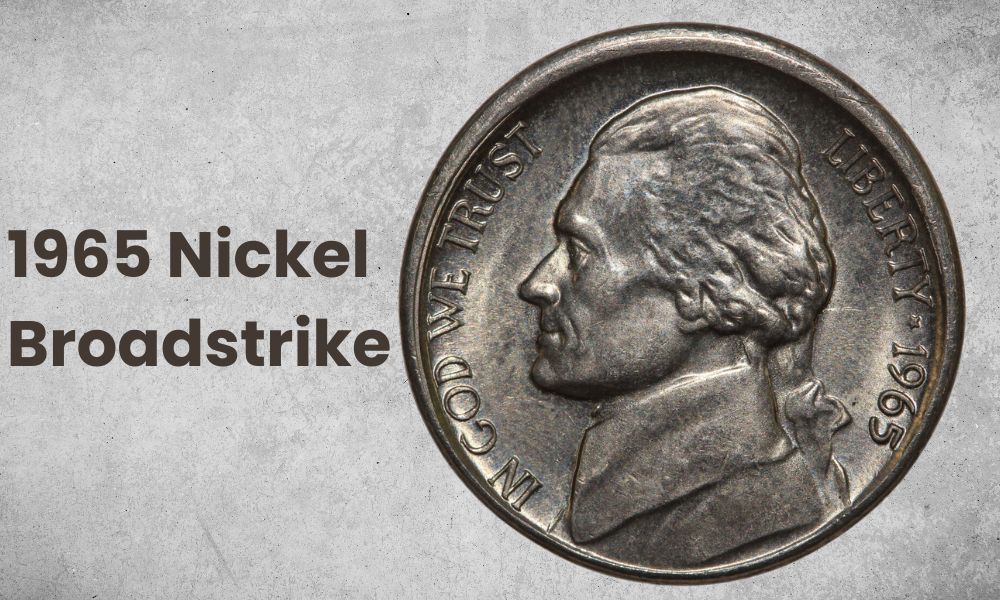
Whenever a coin is struck without a collar, a broad strike error takes place, leaving the coin’s edge wide and uneven. Depending on the number of missing design components and the level of broad strike, these coins may see a rise in their value.
All in all, as you can already deduce that the grading procedure for coins should be recognized by all collectors (whether newbies or pros) who are interested in 1965 nickel errors. Grading establishes the coin’s condition and has a significant impact on its value. To accurately assess the coin’s condition, it is advised to speak with knowledgeable coin graders or study reference books.
1965 Nickel FAQ
1. What is a 1965 nickel?
The 1965 nickel is a five-cent coin minted by the United States Mint in 1965. It features a portrait of Thomas Jefferson on the front (obverse) and a depiction of Monticello, Jefferson’s home, on the back (reverse).
2. What is the current value of a 1965 nickel?
According to the NGC Price Guide, 1965 Jefferson Nickels are worth between $0.10 and $0.20 in circulated condition as of March 2023. On the open market, 1965 Nickels, which are in uncirculated condition, can fetch upwards of $1,000.
3. What makes 1965 nickels so special?
A low-quality 1965 nickel was still in circulation. Coin collectors, however, have recently received upgraded coins from the Mint. Despite being struck in San Francisco, these coins bear no Mintmark. Compared to standard business strikes, these coins have a more convincing proof appearance.
4. On the 1965 nickel, where is the mint mark located?
On “wartime nickels,” the mint mark is much larger and placed above Monticello from 1938 to 1964. Mint marks were not used from 1965 to 1967. A slight clockwise direction from the year’s last digit, between 1968 and 2004. “Liberty” was in effect during the year 2005.
5. What makes a 1965 nickel so valuable?
The value of a 1965 Jefferson Nickel is determined by its grade, condition, and the degree to which the building’s steps have been fully struck (Full Steps). Almost Uncirculated (AU) and lower grades will be worth 5 cents to 50 cents, while uncirculated original specimens will fetch $1 or more.
6. How can I tell if my 1965 nickel is a rare variety or an error?
Get your 1965 nickel certified by a reputable coin grading agency or an experienced coin dealer to find out if it is a rare variant or a mistake. They can examine the coin to determine its state and any peculiar characteristics that might have an impact on its value. Additionally, you can do some research online or consult a coin-collecting book to learn more about the specific varieties and errors to look for.
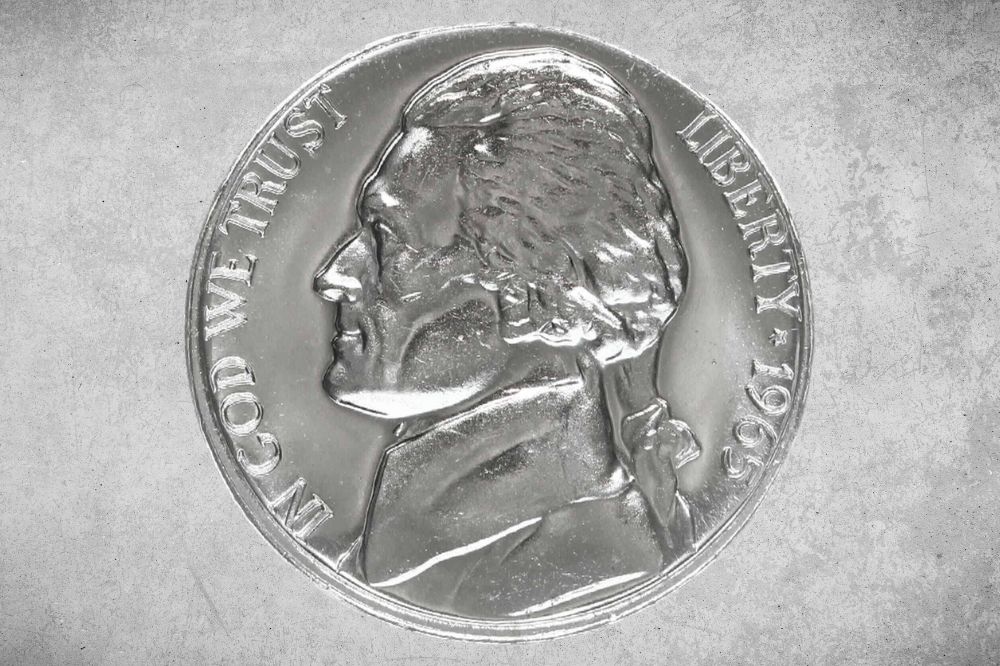
I have a lot of this nickel some from 40s 50s and 60s 70s plus 80s most are rare or double.how can i sell it…. thank for sharing how much this coins worth.